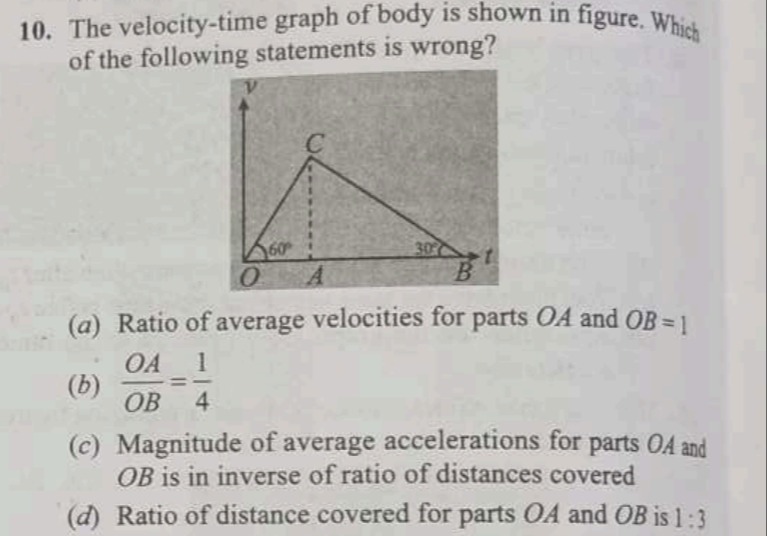Question
Question: The velocity-time graph of body is shown in figure. Which of the following statements is wrong?...
The velocity-time graph of body is shown in figure. Which of the following statements is wrong?

Ratio of average velocities for parts OA and OB=1
OBOA=41
Magnitude of average accelerations for parts OA and OB is in inverse of ratio of distances covered
Ratio of distance covered for parts OA and OB is 1:3
Magnitude of average accelerations for parts OA and OB is in inverse of ratio of distances covered
Solution
Let tA be the time at point A and vmax be the velocity at point C. The slope of OC represents acceleration aOA=tan(60∘)=3. The velocity at C is vmax=aOA×tA=3tA. The slope of CB represents acceleration aCB=tan(150∘)=−31. The time taken for CB is tCB=T−tA, where T is the total time OB. Using vfinal−vinitial=aCB×tCB, we get 0−vmax=−31(T−tA), so vmax=3T−tA. Equating expressions for vmax: 3tA=3T−tA, which gives 4tA=T. Thus, tA=4T. This means OBOA=TtA=41. Statement (b) is correct.
The distance covered in OA (dOA) is the area of triangle OAC: dOA=21×OA×vmax=21tA(3tA)=23tA2. The time taken for AB is tAB=T−tA=3tA. The distance covered in AB (dAB) is the area of triangle ACB: dAB=21×AB×vmax=21(3tA)(3tA)=233tA2. The ratio of distances covered for parts OA and AB is dOA:dAB=1:3. If "parts OA and OB" in statement (d) is interpreted as "parts OA and AB", then statement (d) is correct.
The average velocity for part OA is vavg,OA=OAdOA=tA23tA2=23tA. The average velocity for part OB (entire motion) is vavg,OB=Total timeTotal distance=TdOA+dAB=4tA23tA2+233tA2=4tA23tA2=23tA. The ratio of average velocities for parts OA and OB is vavg,OBvavg,OA=1. Statement (a) is correct.
For statement (c), if "parts OA and OB" refers to the motion during time interval OA and the entire motion during time interval OB: The magnitude of average acceleration for OA is ∣aOA∣=∣3∣=3. The average acceleration for the entire motion OB is aavg,OB=T−0vB−vO=T0−0=0. The ratio of magnitudes of average accelerations is ∣aavg,OB∣∣aOA∣=03, which is undefined. The ratio of distances covered for parts OA and OB (entire motion) is dOA:dtotal=dOA:(dOA+dAB)=dOA:(dOA+3dOA)=1:4. The inverse ratio of distances covered is 4:1. The statement claims ∣aavg,OB∣∣aOA∣=dOAdtotal. An undefined quantity cannot equal 4. Thus, statement (c) is wrong under this interpretation.
